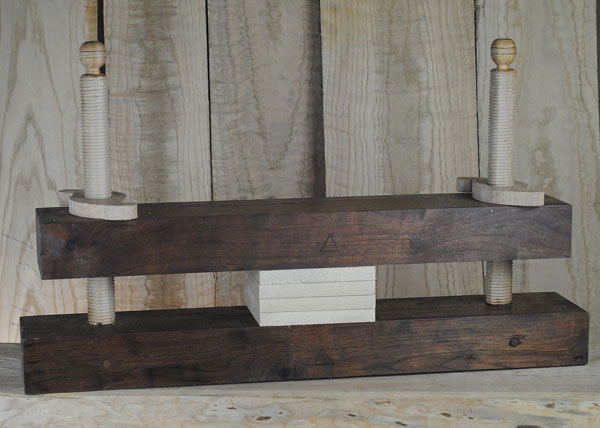We may receive a commission when you use our affiliate links. However, this does not impact our recommendations.
Saturday mornings are among the best hours I get all week. My wife and daughters all like to sleep in late, but I get up early, make coffee, and use that quiet time to read, draw or write. It was a Saturday morning when I turned to Plate 280 of the new translation of “To Make As Perfectly As Possible: Roubo On Marquetry” (Lost Art Press) and found a representation of the press vise I eventually built for an article in the August 2014 issue of Popular Woodworking Magazine.
The first thing I noticed on the plate was a representation of my favorite bench appliance, popularly titled the Moxon Twin Screw Vise. Next to it was something similar, yet captivatingly different. I’d spent a while studying up on veneering as my next skill building adventure in woodworking and was fascinated by the variety of veneer presses out there. Fascinated and unimpressed.
Some press designs used odd-ball clamps I’d have to source; others used vise hardware I’d have to collect in droves. Here was the first press I’d seen that I could build with the tools and supplies I already had in my shop. (Granted I already had a tap and die for making 1-1/2″ wooden threads and screws.) I read a little more, refilled my coffee cup, and took the book with me as I headed out to the shop to build one.
In a few hours the first prototype was birthed in poplar, and it worked well. Days later it was followed by a brother in hickory. As I played with the contraption, I was impressed with the simplicity and utility. Ideas came to mind to improve on what Roubo had shown me. Vanity is a simple sin; it believes your living grey matter trumps the dead stuff and you can out think anyone who has passed away. Vanity is usually wrong.
For example, I thought if I tapped the screws into the bottom beam then I could turn them back out to make storage easier. In practice, I’ve found as I tighten down an S-shaped frame it causes the screw to back out of the base by a little – a troublesome prospect whose issues multiply as you attempt to wrench down both frames to maximum pressure. I relented to Roubo’s wisdom and pinned my screws in place, just like he wrote.
 I also found out that even though one could be made from thinner 5/4 timbers and work well there was nothing quite like using one with the full mass of 3″-thick beams.
I also found out that even though one could be made from thinner 5/4 timbers and work well there was nothing quite like using one with the full mass of 3″-thick beams.
The press vise I built for the article soon left my hands and I waited around to find more appropriate beam stock to make another for myself. After all, I still had the two prototypes to carry me along. Recently I came into just enough 3″-thick walnut slab to build a project and make a new vise. So that’s exactly what I built this weekend.
As I made this one, I spent time thinking about the vise in my shop and how I use it. It’s not an everyday vise, but often it’s just the right thing for the situation. My jump into the dynamic world of veneer has been delayed by other projects and opportunities, but I spent a while this summer gluing up large, multiple piece blocks for turning projects, and the press vise was the perfect contraption for this. What would you prefer, juggle a half dozen clamps in a glue up or just one big one?
Tough decision.
Thus far my press vises have done more work on what Roubo calls “solid wood” as opposed to veneer and it shines. A few months ago I shot some video of a glue up and sped it up a bit so others could get a better feel for the vise in use.
– Derek Olson
Editor’s note: Read more from Derek on his blog at Oldwolf Workshop (he’s in the middle of a Roubo bench build right now – read all about it!)
Here are some supplies and tools we find essential in our everyday work around the shop. We may receive a commission from sales referred by our links; however, we have carefully selected these products for their usefulness and quality.










Nice application of old technology. I like how you didn’t blindly followed Roubo. You tested your idea and then didn’t let your ego get it the way of evaluating the pro / cons of each approach. That Roubo fellow seems to have had a few good ideas about woodworking.
What are the best woods for threading and what is the best coating of the threads to lubricate them.
If staining and varnishing of the wood is planned, would you recommend a different lubrication?
When did Megan get a wife and daughters?